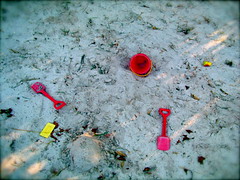The first time I saw the title for Doug Belshaw's doctorial thesis, "
The Never Ending Thesis", I had to smile at the originality.
Now I get it. Thank goodness I am collaborating with
Genna Rodriguez, if not because of the breadth and depth of the project, but just for the moral support! Over the past few days we have been gathering and remixing ideas for the 7C's. Please see Genna's post, "
Holiday, What Holiday?" for the essential questions we have explored for 6 of the 7C's.

In exploring articles and videos on connectivism and rhizomatic thinking... I had the pleasure of extending this to our project. Yes this was beneficial, as it's always nice when ideas
connect, but frankly it started to make my thought process a little
convoluted.
The more you learn, the more you have to incorporate, as your perceptions change.
Learning can be such a pain!
Here is what I was able to pull apart and re-mix based on previous readings from Belshaw and
Fullen to learning then re-shuffle with
Illich,
Siemens,
Jenkins and
Cormier. To further explain, this is a Scope and Sequence for
Connect which is one of the 7C's we are developing. Fortunately, Citizenship (as in
Digital Citizenship) is already completed by the Ministry!
Now keep in mind that the format is off, I was just copy/pasting into this post from OneNote and, it's a draft. Draft... so there is room for revising... lots of room!
Distracted Sidenote: By the way, OneNote is a fantastic tool for collaborating!
Here are the Essential Questions...
Do students make
meaningful connections between their classroom learning, their personal lives,
and the world around them?
Do students see
relationships and overlaps between multiple streams of information? Do the look
for connections between disparate ideas?
Can students
identify and harmonize and draw connections to seemingly unrelated and/or
conflicting concepts and information?
Do students
understand the power and benefits of connections in the globally-connected 21st
century?
Can students create
meaningful networks using various digital tools and social platforms? These networks may include learning networks,
social networks, activism networks, etc.
Are students given
the opportunity to connect beyond the classroom walls with other peers or
experts who help to support this learning process? Are these learning
interactions as valued as traditional views of how learning takes place?
Are schools bridging
the disconnect between traditional
learning models and the realities of the connected 21st century learner?
What metacognitive
processes would students utilize when they assess their own work? Are students tracking progress through e-portfolios
and connecting with other members in their learning network?
Are students given opportunities to engage in
dialogue about their learning with teachers, peers or other members of their
learning network/networked community?
Are students able to engage in diverse learning communities (which include face
to face and digital, as well as inter-generational)?
Are students
learning in networks to exchange knowledge, collect and curate stories and
ideas , as well as engage in collective activities such as crowdsourcing (at a HS level)?
Are students
provided digital spaces where students can engage with inter-generational
experts who help to make up their learning community and helping to develop
social relations in a safe and mediated way?
Here are the Goals for Student Knowledge...
To enrich
understanding in an informational age, students should actively look to make
connections between information, their personal lives, and the world around
them.
Students
know how to find common ground to connect seemingly conflicting concepts and
information.
Student
achievement is enhanced when their learning is reinforced and supported in
multiple settings. These settings can be
online networks where resources and connected conversations are abundant and
accessible.
In the
right networks, students can find a sense of belonging and purpose through
shared interests and passions that will support their growth.
Valuable
information can be accessed through connections outside the school walls and
can significantly support learning.
These networks allow for unprecedented cross-generational and
cross-cultural learning as well.
Students
understand how to access and the value of connecting with multiple people face
to face or digitally to help guide student inquiry. Connected learning promotes
life-long learning and is an opportunity to contribute to the learning of
others.
There are
various digital tools and platforms to connect with others. Students need to carefully consider which
connections will enrich their lives.
Students engage in metacognitive processes and
actively reflect on their learning and connect with teachers in a meaningful
and timely exchange of feedback face to face or through digital networks.
Students
understand how to engage with systems of informal learning in connected
learning environments.
Here is the Scope and Sequence for K - 12, broken into grade groupings...
|
Elementary
K-3
Knowledge
& Skills
|
Middle
Years 4-8
Knowledge
& Skills
|
High
School 9-12
Knowledge
& Skills
|
Students make connections
between information learned and connections to own personal experiences
and other events in the community or around the world.
Students understand that
there are many places where they
can find information to their questions, which includes a variety of
sources which include print, digital and interactions with people. They
are able to identify and notice overlaps of information from sources.
Shares resources from
outside the classroom to the activities of the classroom.
Students understand that
there are people who can provide information to their questions. These
individuals help to make up their learning community.
Students engage and discuss learning
experiences in settings which include at school, home and other
communities of which they interact face to face or online through
teacher mediation, making up the student's learning network.
Students actively engage
in different forms of communication to reach out, connect to explore
and share their questions and ideas with teacher digital support.
Teachers would provide opportunities for whole class connection with
other learning "experts".
|
-Students make
connections between information learned from digital sources and connections
to own personal experiences community or global connections.
Students understand that
there are many places where they
can find information to their questions, which includes a variety of
sources which include print, digital and interactions with people. Able
to identify and notice overlaps of information, as well as identify
reasons for differences.
Contribute
online information and resources from outside into the activities of
the classroom or learning community.
-Students
engage and contribute to an online dialogue with several posts and comments
with other students as part of a teacher-led task.
Students give and act on feedback from
multiple perspectives in teacher created digital networks. Student
incorporates ideas from network into own learning.
Students actively engage
in different forms of communication to reach out and explore ideas from
multiple diverse perspectives
with teacher mediation. Communication may be face to face or teacher mediated digital connections
with peers or other "experts" - depending on student selection for
learning project.
Students
identify instances and describe
benefits of digital technologies being used for the creating and
sharing of knowledge.
Students engage in
dialogue about learning with teachers, peers or other members of their
learning network in face to face as well as digital. Feedback is
captured in digital form for student to act upon.
|
-Students
independently develop their own personal learning network, based on the
student identified learning needs, then develop meaning and co-construct new
information or understandings, drawing on personal experiences, community or
global connections.
-Students
understand the value of different types of information/media, (includes
print, digital and digital interactions with people). Able to analyze
reasons for informational overlaps from sources, as well as identify
differences in information based on perspective and type of information.
Contribute
online information and resources from outside into the activities of
the classroom or online learning community. Able to work effectively
within digital community, by identifying and responding to expectations
or goals of community (such as timelines).
-Students engage and contribute to an online dialogue with
multiple in-depth posts and comments with other students as part of a
teacher-led task, with the goal being to co-constructing knowledge and new
understandings.
-Students give
and act on feedback from multiple perspectives in digital networks.
Connecting with peers significantly shapes the student's learning which is
evident by process and product. Student effectively incorporates comments
from network community into learning.
-Students
actively engage in different forms of communication to reach out and explore
ideas from multiple diverse perspectives using social media platforms. Able
to communicate voice or opinions appropriately as a member of the learning
community.
Students
identify instances and describe
benefits of digital technologies being used for the creating and
sharing of knowledge as a means of exploring various perspectives and
expertise.
-Student
demonstrates the ability to use a variety of online contacts and social
networks to find out information, and able to distinguish between different
online communication tools for usefulness for enabling teamwork and
collaboration.
Student participates in
learning networks to exchange knowledge, collect and curate stories and
ideas , as well as engage in collective activities such as
crowdsourcing as a means of
making connections for student inquiry.
-Students connect with other learners by
collaborating online, use social media to interact with peers around the
globe, engage in conversations in safe online spaces, and bring what they
learn online back to their classrooms.
|
The areas highlighted in green are areas I'm unsure about. The yellow areas potentially should be designated to another "C".
This week we will have the Scope and Sequence completed, then we start the fun stuff... building the website. To make our lives easier, we are going to create in Weebly, then transfer the HTML code from Weebly over to Drupal. This way we can get the benefits of drag and drop, as what is afforded in Weebly but not in the Drupal interface. Basically... our goal to make our site "pretty" may be realized. Yay!
Being that we hope to use these Essential Skills at a school division level, we're starting to feel a little pressure. We need feedback. We need our learning community. But... that's tough to ask when everyone is feeling the pinch of report cards, major projects and regular assignments. Really, I'm not complaining or trying not to... Anyways, if you have time to offer feedback, we would love some!






















